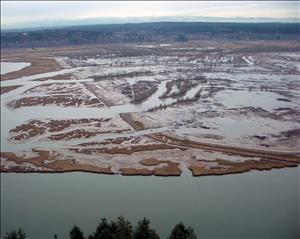On December 4, 1975, heavy rains flood the Nisqually River, causing it to breach the dike surrounding the Nisqually National Wildlife Refuge (later the Billy Frank Jr. Nisqually Wildlife Refuge), allowing salt water to flood some 65 percent of the refuge's grasslands. After some debate, refuge managers get funding to rebuild and reinforce dikes in the late 1970s. Ironically, changing ideas about the environment and the best use of land will inspire a reversal of course in the first decade of the twenty-first century, when a $13 million project will intentionally breach the dikes and restore 762 acres of fields to the original salt marsh environment.
A New Refuge for Wildlife
The U.S. Fish and Wildlife Service established the Nisqually National Wildlife Refuge in 1974 following a long battle between environmentalists and the public ports of Olympia and Tacoma over land use. Port officials saw the Nisqually delta as an ideal place for a new deepwater superport, and proposed construction to dredge the tidelands and fill in surrounding wetlands.
The Nisqually Indian Tribe, local landowners, and environmentalists vigorously fought the proposal from 1965, and rejoiced when the federal government created the refuge. For them, the delta provided invaluable habitat for fish, birds, and amphibians, and numerous opportunities for outdoor recreation. But battles over development surrounding the delta continued for more than 30 years.
Slow Beginning, Dismay, and Rebuilding
A decade after the refuge was established, prolonged heavy rains flooded the Nisqually River, wreaking havoc on local communities and the Nisqually National Wildlife Refuge. The flooding on December 4, 1975, altered the river's channel at Frank's Landing, forced nearby residents to evacuate, and burst through dikes protecting the refuge allowing salt water to flood some 600 acres of grasslands.
The Nisqually flood was a significant setback for the new refuge, much of it occupying the former Brown farm. Alson Brown (1868-1942), a Seattle lawyer turned farmer, had built the dikes to create fields out of tidelands in 1904, but farming on the delta had waned well before the federal government stepped in, and buildings and dikes fell into disarray.
Refuge manager Gene Hocutt burned a number of the older structures that "literally were caving in" and planned to remove an additional six that were too dilapidated for repair, explaining "We decided against renovation ... [because] limited funds would be better spent on biological and educational services" (Tokarczyk, "Nisqually Delta ..."). He decided, however, to keep two old twin barns, because they provided shelter for swallows and owls and were architecturally interesting. Managers fully recognized the aging dikes needed upkeep but simply lacked the funding to reinforce them.
Some environmentalists, however, saw the flood as a positive development: Nature was now reclaiming the land and restoring invaluable habitat. Ecology-minded activists wanted to leave it that way.
Others lamented the sorry state of the refuge in the years after the flood. A Daily Olympian editorialist said driving "by the Nisqually Delta now is a depressing thing" because instead of seeing "a pleasant pastoral scene -- pasture land protected by dikes" one looked out on "a desolate marsh area" (Shacklett) that one refuge manager described as a "biological desert" ("Nisqually Flats Rehabilitation ..."). Ultimately, he concluded, locals should fight any effort to expand the refuge, because "damage already has been done to the flats area of the Nisqually delta" and "enough is enough" (Shacklett).
Refuge managers concluded the dike had to be repaired and grasslands restored. Hocutt explained they wanted "the greatest mix of wildlife possible. So the service favors repairing the dike because diversity of wildlife depends on diversity of habitat" (Tokarczyk, "Nisqually Delta ..."). He noted that populations of Canada geese on the refuge were increasing and thought their numbers would rise "with proper grassland management" (Tokarczyk, "Nisqually Delta ..."). Managers estimated repairs would cost $170,000, and the Fish and Wildlife Service approved funding in 1976.
Crews completed repairs to the dike in 1977, and the following year The Daily Olympian predicted "better times ahead" for the refuge, explaining that Fish and Wildlife planned to replant grasslands killed by salt water and add new "thickets of food-bearing trees" (Tokarczyk, "Better Times ..."). Managers welcomed a growing staff, and began work with consultants to develop plans for wildlife management, recreation, and visitor education. They unveiled their vision in April 1978, and called for $2 million to be spent on further dike improvements, a new park headquarters, trail construction, wildlife-viewing platforms, and recreation areas for hunting, fishing, and boating. Construction of the improvements forced the refuge to close briefly in 1979, but gates to the newly revitalized facility reopened in early 1980.
Reversing Course
In the early years of the twenty-first century, a growing focus on the environment and changing priorities led refuge leaders to reevaluate the dike system. They realized that spawning salmon and migrating birds needed salt marshes, concluded that the dikes had to go, and launched a $13 million project to breach them. In November 2009, they celebrated as the dike Alson Brown had built a century earlier was removed and the tide washed over 762 acres, reconnecting them to the tidal salt water of Puget Sound, restoring habitat, and reversing the repair work done in the 1970s.
Combined with some 150 acres that the Nisqually Tribe had earlier restored to tidelands, the Nisqually Delta work constituted "the largest tidal marsh restoration project in the Pacific Northwest" and was seen as a significant step in ongoing efforts to promote the recovery of Puget Sound generally and its salmon population in particular ("About the Nisqually Delta Restoration Project").
Among those who had called for removal of the dikes and celebrated the return of the tidelands and their salmon habitat was Nisqually leader and fishing-rights activist Billy Frank Jr. (1931-2014), who had long championed protecting the Nisqually River and delta, home to his Nisqually people for millennia. In 2015, a year after his death, the refuge was renamed the Billy Frank Jr. Nisqually National Wildlife Refuge in his honor.

